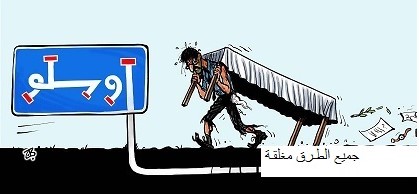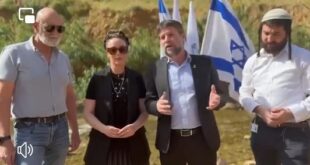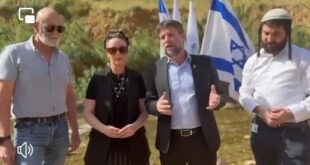By: Madeeha Al-A’raj
The national Bureau for Defending the Land and Resisting Settlements stated in its latest weekly report , that the Oslo Agreement ‘Declaration of Principles Agreement’ was signed in the White House in Washington on 13 Sept. 1993, and on 28 Sept. 1995, the Palestinian-Israeli Interim Agreement was signed in Taba, Egypt, where the West Bank was divided into areas A,B, andC, where area ‘A’includes large Palestinian cities and towns, area ‘B’ includes villages and small towns, and area ‘C’the largest area that is about 62% of the area of the West Bank subject to full Israeli control. This division of the West Bank was not arbitrary, coincidental, or meaningless, as much as it was deliberate and indicative of hidden goals, the extent of its danger came to light in subsequent years.
AreaC according to the interim agreement was the target of the occupying state’s ambitions as a vital area for its settlement project. 99% of this area is completely excluded from Palestinian use, and the occupation authorities do not allow Palestinians to build in it for residential, commercial or industrial purposes. It contains most of the natural resources in the West Bank and contains the main water basins with the exception of the northeastern basin in Jenin Governorate, and it contains open spaces that were the source of income of the Palestinian farmers and 70% of its lands are defined as being within the municipal boundaries of settlement.
Area C was targeted by settlers from the beginning, where settlement has gone through three waves. Itseems that we are on a date with its fourth and final stage. The first wave was the period of Labor Party rule between 1967 and 1977, when a number of settlements were built, amounting to about 31 settlements, the most important of which were in the Greater Jerusalem area and in Gush Etzion in the Bethlehem Governorate and in the Jordan Valley, in addition to the settlement that was established on the lands of the destroyed villages ‘Yalo, BeitNoba, Latrun’. As the number of settlers rose to 2,876 settlers. The focus at that time was on Gush Etzion, the Jordan Valley, and the Greater Jerusalem area. As for the rest of the West Bank, Israel built only one settlement there.
The second wave came after the rose of the extreme right-wing gov’t led by Menachem Begin to power and after the signing of the peace agreement with Egypt. At the end of the 70s and the beginning of the 80s, Israel established 35 settlements followed by 43 new settlements until the end of 80s. Settlement activities escalated in the period that accompanied the Madrid and Washington negotiations between the Palestinian and Israeli sides, following the 1stGulf War in 1991. The government of Yitzhak Shamir established 7 new settlements and the number of settlers rose to 107,000, bringing their percentage to 5.3% of the general population of the West Bank and Gaza Strip. .
As for the third wave, it was after the signing of the Oslo Accords. Settlement activities continued, settlement expansion took place, bypass roads were opened, and military orders were issued ordering the seizure of Palestinian lands, contrary to what was included in the Oslo Accords, which stipulated that neither party may initiate or take any step. It would change the situation in the West Bank and Gaza Strip until awaiting the results of the final status negotiations, as if Israel was in a race against time to impose more new facts on the ground.
The Israeli governments used the signed agreements with the Palestinians just as they used the Palestinian-Israeli negotiations as a political cover for their settlement activities. Until we reached, prior to the last elections for the Israeli Knesset in 2022, 158 settlements in the West Bank including East Jerusalem inhabited by about 700,000 – 750,000 settlers, in addition to 15,000 – 20,000 settlers living in more than 200 outposts that began to transform over time into incubators for Jewish terrorist organizations, such as the ‘Hill Youth’ Organizations, ‘Pay the Price’ and other organizations calling themselves “rebellion.”
With theexpansion of settlements, there is no longer talk of political settlements ‘that can be dismantled’ and security settlements, as Yitzhak Rabin put it, but rather of a settlement-colonial structure on an area of 600,000dunums, constituting about 12% of the area of the West Bank in addition to about 2,000,000dunums, which is an area of influence of the regional councils of the settlements, so that the area of Palestinian lands under the direct control of the settlements, including settlement outposts and so-called pastoral farms amounts to about 40% of the total area of the West Bank.
The 4th wave of unprecedented settlement activity and destructive Israeli plans began with the rise of the fascist and neo-Nazi right to power in Israel after the last elections for the Knesset, which took place in Nov. last year, which aimed to raise the number of settlers in the West Bank including East Jerusalem to about 1,000,000 settlers over the next 2 years. For his part, BezalelSmutotrich, Minister of Finance and Minister of Settlements in the Ministry of the Army prepared a settlement plan that includes dozens of settlement projects between new construction, including new settlement cities and the legalization of about 155 settlement outposts and pastoral farms, so he requested 2 weeks ago to postpone the discussion of granting “legitimacy” to a number of settlement outposts in the Israeli Knesset, pending the crystallization of his destructive settlement project.
Doing so, Smotrich intersects with both Ben Gvir and Netanyahu, in Jerusalem there are new settlement cities such as “New Talpiot” and “Kadmat Zion”, bypass roads and a light train, and in the rest of the West Bank governorates there is a return to settlement, which the Sharon’s gov’t evacuated in 2005 in the Jenin Governorate. Intensifying and developing pastoral settlement in the al-Aghwar areas, starting with the areas located to the east of the towns of BeitDajan and Ben Furik, going up to the north in the areas of Beita, Qasra, MajdalBaniFadil, Douma, Jalo, and Qaryut in the Nablus Governorate, and in the areas of Turmusaya, BaniFalah, al-Mughir, KafrMalik, and Marjat al-Taybeh in the Ramallah Governorate, and Al-Bireh all the way to the Jerusalem desert in the direction of the Jordan Valley and the city of Jericho.
For this purpose, the occupation government has allocated about NIS 3.5 billion shekels to prepare the necessary infrastructure for such projects, including accelerating the completion of a number of new bypass roads, which exempt settlers from traveling in areas populated by Palestinian residents. Benjamin Netanyahu is not far from Smotrich’s settlement plans and projects. He encourages them in the context of a long-term project that talks about moving settlement to a new qualitative stage.
In numbers, we will realize the extent of the dangerous development that has occurred in the settlement project in the West Bank including East Jerusalem.
Thepopulation statistics for settlements issued by the Israeli Central Bureau of Statistics, and the Settlements Council i.e. “Judea and Samaria,” the number of settlers in the West Bank excluding East Jerusalem, when the first Oslo Accords was signed in 1993 was about 115,000, and it rose in 1999 to about 177,411 and in 2005 to 249,901, in 2010 to 313,928, in 2015 to 388,285, and in 2018 to 430,147, reaching by the end of the year 2022 more than 500,000 settlers, residing in 158 Israeli settlements in the West Bank, including 24 in East Jerusalem.
In addition, there are about200 illegal Israeli settlement outposts and pastoral farms inhabited by about 25,000 settlers, the vast majority of whom are “Hill Youth” and “Price Pay” terrorist thugs. In total, more than 500,000 Israeli settlers now live in the West Bank, in addition to 250,000 residing in East Jerusalem, meaning that the total exceeded 750,000 settlers, which constitutes seven times the number in 1993.
Within the context, the daily agenda of the fascist and neo-Nazi government in Israel is crowded with destructive settlement projects and plans within the policy of decisiveness and annexation, which it is working on at a high pace. Since the beginning of this year, this government has pushed forward plans to establish 12,885 settlement units throughout the West Bank, the largest of which is in the “Ma’leAdumim” settlement east of the occupied Jerusalem, where 1,475 settlement units were approved, and the “Eli” settlement northeast of Ramallah, where they were approved1081 settlement units and “Kochav Yaakov” in the central West Bank, 627 settlement units, and “GivatZeev” northwest of Jerusalem 559 settlement units.
And the El-Kana and Kedumim settlements in the Qalqilya Governorate, with the construction of 350 settlement units in the first and 380 settlement units in the second, and the KiryatArba settlement in the Hebron Governorate, about 374 units in a settlement. As for the city of Jerusalem, the occupation government is examining plans to establish 7,082 settlement units in different areas of the city. According to what the Hebrew media indicated in its reports.
The daily follow-up of the activities of theSettlement State, it appears that the plan to develop East Jerusalem announced by the occupation government has receded into the shadows, but in any case, it is mainly a Judaization and Israelization plan and false promises to build in the towns, villages, and neighborhoods of Jerusalem. It has been replaced by settlement expansion plans as a priority. Last week, the Planning Committee of the so-called Israeli Civil Administration announced two detailed plans targeting large lands belonging to the towns of Al-Khader and Battir and the village of Al-Walaja, west of the city of Bethlehemin order toestablish a new settlement on their lands called “Arhoumah”. The talk here is about hundreds of acres of threatened citizens’ lands.
The new settlement is located within the implementation area of the “Greater Jerusalem” plan, thus forming a link between the borders of the city of Jerusalem on the western side, and the settlements of the Gush Etzion bloc to the south in the Bethlehem Governorate, thus strengthening the separation of the towns of Battir and Al-Walaja from their surroundings and isolating them from it. Regarding the lands of Al-Khader village, the plan aims to expand the Eliezer settlement established on its lands, which include tens of dunams, which are lands privately owned by citizens.
The District Planning and Building Committee in occupied Jerusalem also discussed approving the construction of the settlement neighborhood “Kadamat Zion” on the lands of Abu Dis, which would close the wider circle around the Old City from the south and east if implemented and would push more settlers into the area. Settlement companies supported by the extreme right have submitted more projects to expand the construction plan to include parts of the lands in the southern region with a strip of towers that fit the topography of the mountainous area overlooking the walls of the Old City. Committee member AbalaGreisky described the settlement “neighborhood” as part of a comprehensive plan to connect the settlements to the east of “Jabal al-Kubar” with each other and to connect these settlement neighborhoods to the American Street on the lands of Sur Baher and Umm Tuba, all the way to the settlement of Jabal Abu Ghneim (HarHoma) to form an interconnected bloc. Of the settlement outposts in the eastern part of Jerusalem completely, it completely encircles Ras al-Ain, WadiQaddum, Silwan, Al-Aqsa Mosque, and the Old City. It is expected that the number of settlement units in this problematic new settlement neighborhood will be raised from 400 settlement units near the annexation and expansion wall that passes through the town of Abu Dis to 560 units.
At the same time, following its weekly session, the occupation government transferred to the occupation municipality in Jerusalem an amount of NIS 350 million to strengthen the light train network linking the settlements of occupied East and West Jerusalem, with a focus on the so-called Blue Line. An additional amount of about NIS 31 million was also approved to enhance the so-called Purple Line light rails. Meanwhile, the expansion and modifications to the line linking the “Gilo” settlement, south of occupied Jerusalem, to the industrial zone ‘Atarot’ were unveiled, and the implementation was entrusted to a company affiliated with the municipality /Moria Company in cooperation with the Ministry of Transportation. The Blue Line route extends for 31 kilometers and 52 stations from the “Gilo” settlements in the south of the city to “Ramat Eshkol” and the “Ramot neighborhood” north of the Old City.
In parallel, the occupation municipality in Jerusalem approved a new settlement plan that would confiscate large areas of the city of Bethlehem’s land, according to the Applied Research Institute “ARIJ,” in order to establish a parking lot for different types of buses and all its supporting services, such as offices, drivers’ rooms, washing stations, and supply stationswith fuel, energy rooms, and related technical facilities, in addition, the new settlement plan grants the rights to build parking lots in the second phase of implementation. The lands targeted in the plan are located north of the Israeli crossing known as “Rachel-Gilo 300 Crossing,” which was established by the occupying State north of the city of Bethlehem in 2005 to limit the Palestinians’ use of the Bethlehem-Jerusalem road leading to the Holy City, which was considered a vital street before the outbreak of the Second Intifada. It alsocuts the historical, religious and geographical connection between the two cities “Jerusalem and Bethlehem”.
Moreover, the occupation authorities also working to establish a bus station to facilitate the movement of settlers in the settlements of the Nablus and SalfeetGovernorates on an area of ‘56 dunums’ of land in the eastern village of Yasuf, in an area called “Al-Sha’b” area. This prospective station is located next to bypass road n. 60, in addition to being only 700 meters west of the “Rahalim” settlement, which is located on the lands of the villages of Yasuf and Yatma.
Within his electoral propaganda for the municipal elections that will take place next October, where he competes with Aryeh King, the godfather of settlement in the Palestinian neighborhoods for the “Jewish Power” party led by the extreme right-wing Itamar Ben Gvir, Moshe Leon confirmed that his municipality recommended ‘the Israeli Regional Planning Committee at the Ministry of the Interior approved an expansion plan for a new neighborhood in the ‘GivatHamatos’ settlement on the lands of the town of BeitSafafa on an area of 140 dunums and in an archaeological and historical area, by building 3,500 settlement units and 1,300 hotel rooms south of the city of East Jerusalem, with residential towers from 16 to 45 floors, 30% of which ‘about 1,000 units’ are allocated for rent to the municipality.
List of Israeli Assaults over the Last Week Documented by the National Bureau:
Jerusalem:
- Seizing a house belonging to the Idris family in the Al-Qurmi Neighborhood in the Old City of occupied Jerusalem, protected by the occupation police. The residents living in the neighborhood were surprised to hear the sounds of settlers storming the house with heavy guard, changing the doors and placing iron protections for the windows and roof of the house that belongs to the family since 1979, and they have the ownership papers.
Hebron:
- Halting construction order on the home of citizenMahmod Abu Qubaita in MusaferYatta in the “Lasifer” area adjacent to the Apartheid Wall.
Bethlehem:
- Attacking citizen Ashraf Ali Ghoneim, fractured his feet as a result near the town of Al-Khader, where a group of settlers attacked his family while they were on their land in the Al-Thaghra area adjacent to the “Daniel” settlement. They also attacked citizens’ homes in the Khalayil Al-Looz area and threw stones at their homes.
- Halting construction on a house and seized a concrete pump and mixer in the village of Al-Ma’sara, south of Bethlehem, belonging to the citizen Ibrahim Hassan Zawahra, under the pretext of not having a license.
Ramallah:
- Storming the village of Burqa and seized a tank pumping wastewater, belonging to the citizen Sanad Adnan Barakat, under the pretext of working in Area C.
Nablus:
- Seizing 2 bulldozers that were working on constructing agricultural roads in Howara, on the northern side of the town, with a length of 1.5 km, and prevented the continuation of work there, under the pretext that they are located n Area “C”.
- Attacking citizen, IyadRagheb Salah, while he was in the Al-Masoudiyah area which belongs to the lands of village north of Nablus. They beat him and threw stones at him, causing him to suffer bruises all over his body.
Jordan Valley:
- Attacked citizen, Ahmed Hussein Daraghmeh, while he was grazing his livestock east of Al-Farisiya in the northern Jordan Valley, broke his arm.
- Demolition order of 3 homes within a week, and the cessation of work and construction in 14 others in the village of Al-Duyuk Al-Tahta, west of the city of Jericho under the pretext of not having a license, raises the number to 50 houses threatened with demolition in the village.
 المكتب الوطني للدفاع عن الارض ومقاومة الاستيطان منظمة التحرير الفلسطينية
المكتب الوطني للدفاع عن الارض ومقاومة الاستيطان منظمة التحرير الفلسطينية




